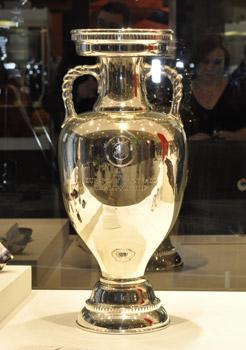
| HOME |
| NERVE |
| REVIEWS |
| ARCHIVE |
| EVENTS |
| LINKS |
| ABOUT US |
| CONTRIBUTORS |
| BACK ISSUES |
| CONTACT US |
 Only A Game?
Only A Game?
UEFA Exhibition
World Museum, William Brown Street
11th October 2008 – 1st March 2009
Reviewed by Anthony Swords
The title of Liverpool’s newest exhibit at the World Museum is interestingly posed as a question. Amid rows over foreign ownership and accusations of greed within the game, this exhibition is a timely reminder of football’s place within the popular consciousness.
In keeping with the museum’s ethos of family orientated and education driven displays, ‘Only A Game?’ is both a bright and accessible display of memorabilia and trophies from European football’s history. Throughout the space, footage plays on screens that neatly tie together the game’s black and white heroes with today’s multimillionaire superstars.
While the exhibit glosses over the darker passages and tragedies that have played a major part in the European game, the show does remind the viewer of the sport’s power to unite countries and communities. UEFA’s work in educating fans on issues such as racism are shown as ongoing campaigns as well as providing a forum for fans to trade cultural and regional ideas and promote identities.
Phil Thompson was on hand to emphasise these points. As a fan that first went to the Kop in the 1960s and then enjoyed a career as a Liverpool footballer, coach and manager, it is fair to say that the Sky Sports pundit has lived a life in football. His passion and insight into the game has not diminished and his views are refreshing in light of many who say the game has sold it soul. “People forget what we had to put up with in the seventies and eighties”, he explains. ‘Hooliganism was rife and many of the grounds were in a terrible state.’
Thompson believes that in order for the game to grow, change was essential. In so doing it has encouraged “diversity in its fan base and made the game accessible to many more people”. Society was changing while football was stagnating and as some will shout about football’s loss of identity in light of the growing amounts of money, Thompson believes it now reflects a wider cross section of society.
How fitting then that in its year as Capital of Culture, a city that has undoubtedly produced more success and done more to promote the spirit and energy of the game than many bigger European cities, should host this exhibit.